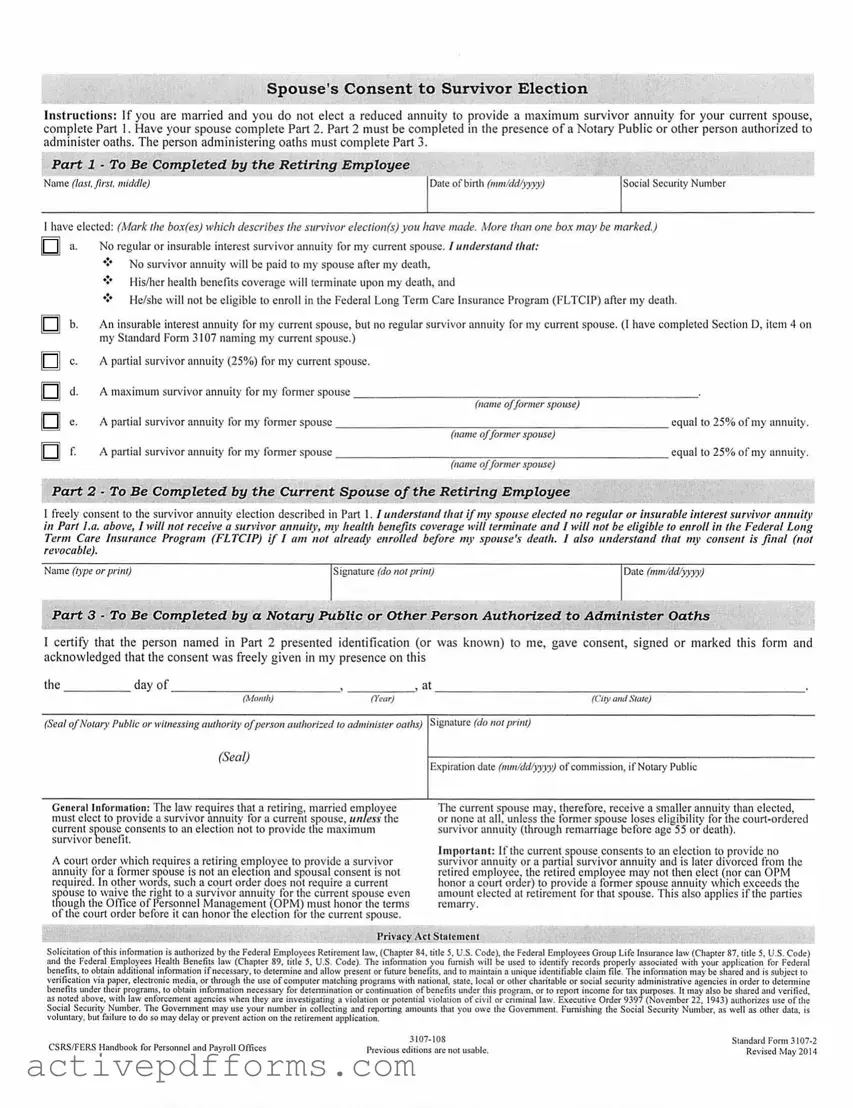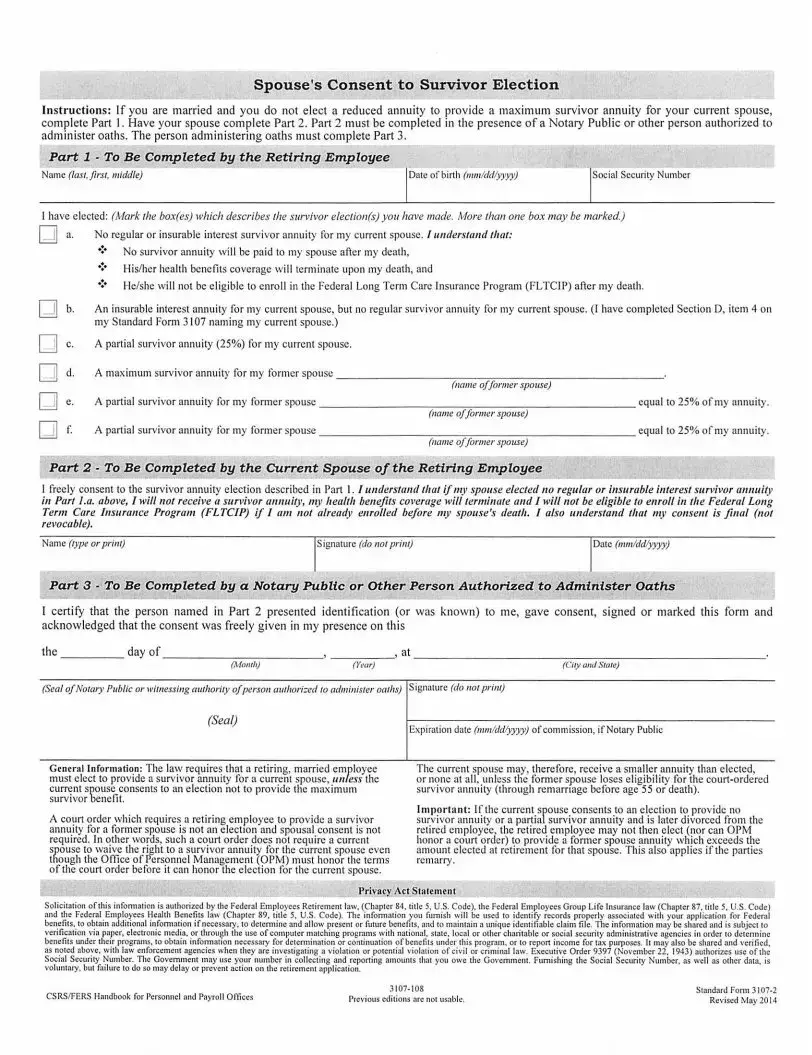Spouse's Consent to Survivor Election
Instructions: If you are married and you do not elect a red uced annuity to provide a maximum survivor annuity for your current spouse, complete Part 1. Have your spouse complete Part 2. Part 2 must be completed in the presence of a Notary Public or other person authorized to administer oaths. The person administering oaths must complete Part 3.
Part 1 - To Be Completed by the Retiring Employee
Name (last.first. middle) |
Date of birth (111111/ddlyyYJ~ |
Social Security Number |
1 have elected: (Mark the box(es) which describes the survivor election(s) you have made. More than one box may be marked.)
No regular or insurable interest survivor annuity for my current spouse. / understand that:
•!• No survivor annuity \viii be paid to 111y spouse after my death,
❖His/her health benefits coverage will term inate upon my death, and
❖He/she will not be eligible to enroll in the Federal Long Term Care Insurance Program ( l'LTCIP) after my death.
An insurable interest annuity for my current spouse, but no regular survivor annuity for my current spouse. (1have completed Section D, item 4 on my Standard Form 3 107 naming my current spouse.)
A partial survivor annuity (25%) for my current spouse.
A maximum survivor annuity for my fo rmer spouse ---------- |
--,--- -=-=--- - - . , ----------- |
|
(11ame offormer spouse) |
Apartial survivor annuity for my forme r spouse ----------- , ---~ ------ , ---------- equal to 25% of my annu ity. (11a111e offormer spouse)
□ f. A partial survivor annuity for my former spouse ---------- |
. , -- -:-:------- |
, -------- -- equal to 25% ofmy annuity. |
|
(name offormer spouse) |
|
Part 2 - To Be Completed by the Current Spouse of the Retiring Employee
1 freely consent to the survivor annuity elect ion described in Part 1. / understand that if nu• spouse elected 110 regular or insurable interest survivor a111111i~)• in Part I.a. above, I will not recei ve a survivor annuity, my health benefits coverage will terminate and I will not be eligible to enroll in the Federal Long Term Care Insurance Program (FLTCIP) if I am not already enrolled bef ore my spouse's death. I also understand tlwt my consent is final (not revocable).
Name (rype or print) |
Signature (do not prim) |
Date (mm/ddlyyyy) |
Part 3 · To Be Completed by a Notary Public or Other Person Authorized to Administer Oaths
I certify that the person named in Part 2 presented identification (or was known) to me, gave consent, signed or marked this form and acknowledged that the consent was freely given in my presence on this
the _____ day of ________ ____, ---- , -- ~ at _ ___ _______,, --- . , ------------ -
(Mo111hJ |
(Year) |
(Ci1y atul S1a1e) |
(Seal ofNotary P11blic or witnessing awhority ofperson authori=ed to administer oaths)
(Seal)
Signature (do 1101 print)
Expiration date (111111/ddlyyyy) of commission, if Notary Public
Genera l Information: The law requires that a retiring, married employee must elect to provide a survivor annuity for a current spouse, unless the current spouse consents to an e lection not to provide the maximum survivor benefi t.
A court order which requires a retiring emp loyee to provide a survivor annuity for a former spouse is not an elecllon and spousal consent is not required. In other words, such a court order does not require a current spouse to waive the right to a survivor annuity for the current spouse even though the Office of Personnel Management (OPM) must honor the terms o f the court order be fore it can honor the election for the current spouse.
The current spouse may, therefore, receive a smaller annuity than elected, or none at all, un less the former spouse loses eligibility fo r the court-ordered survivor annuity (through remarriage before age 55 or death) .
Importan t: l f the current sf ouse consents to an election to provide no survivor annu ity or a partia survivor annuity and is later divorced from the retired employee1 the retired employee may not then e lect (nor can O PM honor a court oroer) to provide a fo rmer spouse annuity which exceeds the amount e lected at retirement for that spouse. This also applies if the parties remarry.
Privacy Act Statement
Solici1a1io11 of this infonnation is authorized by the Federal Employees Retirement law. (Chapter 84. title 5. U.S. Code), the Federal Employees Group Life Insurance law (Chapter 87. title 5, U.S. Code) and the Federal Employees Health Benefits law (Chapter 89, title 5. U.S. Code). 11,e infonnation you fumish will be used 10 identify records properly associated with your application for Federal
benefits. 10 obtain additional infonnalion ifnecessary, to dctcm1ine and allow present or future benefi1s, :rnd to maintain a unique identifiable claim fi le. The infonnation may be shared and is subject 10 vcrifica1ion via paper, electronic media, or throu~h the use of computer matching programs with national. slate, loc,11 or other charitable or social security administrative agencies in order to dctcnninc benefits under their programs. to obtain infonnnuon necessary for dctcnnination or continuation of benefits under this progr:un. or to repon income for tax purposes. It may also be shared :md \'Crificd, as noted abo\'e. with law enforcement agencies when they arc in\'cstigating a violation or potenlial violn1ion of civil or criminal law. Executive Order 9397 (November 22, 1943) authorizes use of the Social Security Number. 111c Govenunent may use your number in collecting and reponing amounts that you owe the Government. Furnishing the Social Security Number. as well as other data, is voluntary, but fai lure to do so may delay or prevent ac1ion on the rct ircmenl applicalion.
CSRS/FERS Handbook for Personnel nncl Payroll OfTices |
3 107-1 08 |
Standard Fonn 3107-2 |
Previous editions .uc not usnblc. |
Revised May 20 I4 |

